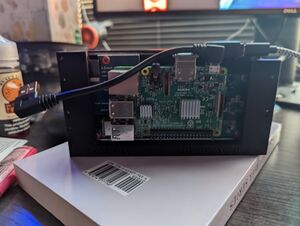Check out my first novel, midnight's simulacra!
Waveshare AMOLED: Difference between revisions
Jump to navigation
Jump to search
No edit summary |
|||
| Line 7: | Line 7: | ||
==Assembling front pane== | ==Assembling front pane== | ||
[[File:Amoled-hookups.jpg|thumb|right|USB hookups in brace]] | |||
* Insert AMOLED into brace by slowly pushing it down | * Insert AMOLED into brace by slowly pushing it down | ||
* Insert micro-USB touch input bridge into AMOLED | * Insert micro-USB touch input bridge into AMOLED | ||
Revision as of 10:26, 28 May 2022
I am using a 5.5" Waveshare AMOLED capacitive screen in my workstation, together with a Raspberry Pi 3B. They are powered over USB from Molex, and receive data using IP-over-USB together with an internal USB3 header. It's a great little device at a good price point (about $130), though quite fragile.
The Waveshare wiki page for the device is a good place to start. The screen takes anywhere from 250 to 650mA, using more power to display lighter, brighter pixels.
Console rotation
Write 1 to /sys/class/graphics/fbcon/rotate. To do it from the kernel, add fbcon=rotate:1 to the kernel command line; in Raspbian, this is done by editing /boot/cmdline.txt. This has no effect on Xorg.
Assembling front pane

- Insert AMOLED into brace by slowly pushing it down
- Insert micro-USB touch input bridge into AMOLED
- Mate Raspberry Pi to AMOLED via touch input bridge
- Insert HDMI bridge into AMOLED and Raspberry Pi
- Insert left-angled micro-USB cable into Raspberry Pi
- Insert right-angled micro-USB connector into AMOLED
- Insert straight micro-USB cable into connector
- Insert Ethernet cable into Raspberry Pi